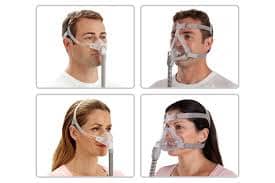
Best CPAP Mask Styles can make a huge difference — especially if you’ve been using a CPAP machine for a while and already know one truth: not all masks are created equal. For side sleepers and mouth breathers, finding the right CPAP mask can feel like an endless trial and error. You want comfort, you want a good seal, and most importantly, you want to actually sleep through the night without waking up to air leaks or sore spots.
The good news? The right mask design can change everything. Let’s look at how different CPAP mask styles fit the needs of side sleepers and mouth breathers — and how you can find one that truly works for you.
Understanding the Struggles of Side Sleepers Using CPAP Masks
Sleeping on your side is one of the healthiest positions for reducing snoring and improving airflow. But for CPAP users, it can quickly turn into a challenge. Traditional full-face masks are bulky, and the side pressure can cause air leaks, noise, or painful red marks on your cheek.
Many side sleepers end up overtightening their straps to stop leaks, which often makes things worse. The trick is finding a CPAP mask designed for side sleepers — one with low-profile frames, soft cushions, and flexible tubing that moves with you instead of against you.
Tip: Look for CPAP masks that have a hose connection at the top of the head. This simple design helps you move freely without tugging on the tubing.
Why Mouth Breathers Need Special CPAP Mask Styles
If you breathe through your mouth while sleeping, a nasal mask won’t do the job — no matter how comfortable it feels. When your mouth opens, the air escapes, reducing the pressure your CPAP machine delivers. The result? You wake up tired, dry-mouthed, and frustrated, even though you wore your mask all night.
That’s where CPAP mask styles for mouth breathers come in. Full-face masks or hybrid models are ideal because they cover both your nose and mouth, keeping the pressure steady even if your jaw relaxes.
If you dislike bulky full-face masks, newer designs like the Bleep DreamPort or minimal hybrid masks can give you that seal without the weight.
Best CPAP Mask Styles for Side Sleepers
Finding a mask that stays put while you move is key. Here are some of the best styles for side sleepers:
- Nasal Pillow Masks:
Lightweight and minimal, these masks seal right at the nostrils. They’re perfect for side sleepers because they don’t press into your face when you roll over. Models with flexible tubing allow natural movement throughout the night. - Nasal Cradle Masks:
These rest gently under the nose rather than inside it. They offer a stable seal with less irritation — ideal if you find nasal pillows too direct or uncomfortable. - Low-Profile Full-Face Masks:
Newer full-face designs, like those from Bleep or ResMed, feature soft silicone cushions and compact frames that don’t stick out as much. They stay sealed even when your face shifts on the pillow.
Best CPAP Mask Styles for Mouth Breathers
For those who breathe through their mouth while sleeping, comfort starts with a mask that prevents air leaks without feeling claustrophobic.
- Full-Face Masks:
These remain the most effective for mouth breathers. They cover both the mouth and nose, maintaining consistent airflow. Look for a mask with a soft seal and adjustable straps to prevent leaks around the chin. - Hybrid Masks:
A mix between a nasal pillow and a full-face mask, hybrids give you coverage without bulk. They sit under the nose and cover just the mouth — great for users who dislike forehead straps or heavy frames. - Mask-Free Options (Bleep DreamPort):
For those who hate headgear altogether, systems like the Bleep DreamPort offer a headgear-free experience. Adhesive ports attach gently to your nose, giving you freedom of movement and a completely open field of vision.
Tips to Improve Comfort and Seal Quality
Even the best CPAP mask needs a bit of fine-tuning. Here are a few expert-backed suggestions to make your setup work better:
- Adjust before you sleep: Don’t tighten straps after lying down. Fit the mask while you’re sitting upright, then test it lying on your side.
- Keep it clean: Oils from your skin can break the seal. Wash your cushion daily with mild soap and water.
- Replace parts regularly: Cushions and headgear stretch over time. Replace them every few months to maintain the perfect seal.
- Use a CPAP pillow: These specially shaped pillows reduce mask pressure on your face, helping to prevent leaks when you roll over.
Why Your Sleeping Position Matters
Your sleep position plays a bigger role in therapy success than you might think. Side sleepers often get better airflow naturally, but only if the mask fits right. Mouth breathers, on the other hand, need a design that seals completely — otherwise, even the best CPAP machine can’t deliver proper pressure.
Combining both needs — side sleeping and mouth breathing — means choosing a mask that’s both slim and secure.
Finding the Right Mask for You
There’s no single “perfect” CPAP mask. What feels right for one person might be uncomfortable for another. The best approach is to test different CPAP mask styles for side sleepers and mouth breathers, noting which designs let you move naturally and still keep a good seal.
If you struggle with leaks or discomfort, talk to your sleep therapist or equipment provider. Small changes — like switching to a mask-free system or adding a heated humidifier — can dramatically improve your sleep quality.
Final Thoughts
Choosing the right CPAP mask isn’t just about comfort — it’s about making your therapy work the way it’s supposed to. When you find the right fit, you’ll breathe easier, sleep deeper, and wake up genuinely refreshed.
Whether you’re a side sleeper, a mouth breather, or both, the key is personalization. The best CPAP mask is the one that lets you forget it’s even there.
